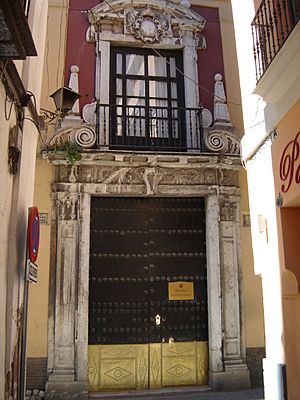Palace of the Countess of Lebrija facts for kids
The Lebrija Palace (also known as the Palacio de la Condesa de Lebrija) is a special house-museum in the city of Seville, Spain. It was first built in the 1500s and later updated between the 1700s and 1900s. This palace is famous for its amazing collection of art. You can find ancient Roman mosaics, old items from Asia, beautiful paintings by famous European artists, and fancy decorations from Europe.
Inside, the palace shows off many different building styles. You'll see Moorish arches, detailed Plateresque designs, and colorful tiles that were saved from old ruined convents. There's even a special wooden ceiling from another 16th-century palace and a cool Renaissance border design. The outside look and how the palace is laid out are typical of the Andalusia region.
History of Lebrija Palace
Building this grand house for a noble family started in the 1400s. Its front part was finished in the 1500s. Over the years, the palace was changed and made bigger many times, from the 1700s to the 1900s. When it was first built, it belonged to the Paiba family. Later, different noble families owned it, including the Count of Corbos and the Counts of Miraflores.
In 1901, a very important person named Regla Manjón Mergelina, who was the Countess of Lebrija, bought the palace. She loved archaeology, which is the study of old things. She worked hard to fix up and rebuild the palace so she could keep her valuable collection of ancient items there. The Countess filled the palace with artifacts she found herself during digs, and also bought items from other archaeologists and friends.
The palace is quite large, covering about 2,500 square meters across two floors. The ground floor was used during the hot summer months, and the upper floor was used in winter.
Amazing Art Collection
The Lebrija Palace is especially famous for its Roman mosaics, which cover almost the entire ground floor. A Spanish historian named Juan de Contreras once said it was the "best paved house-palace in Europe."
One of the most special mosaics shows the god Pan. This mosaic was found on land owned by the Countess herself! You can see it in the palace's main courtyard. In the middle of the mosaic, Pan is playing his flute for Galatea. Other round pictures in the mosaic show love stories of Zeus, and the corners have pictures of the four seasons.
Another cool part of the collection is the opus sectile work. This is a type of art made from different colored marbles fitted together, and it paves the entrance hall. The palace is full of old Greek and Roman busts (sculptures of heads and shoulders), pictures of gods and goddesses, and items from the Moorish era, China, and Persia.
You'll also find a great collection of old well curbs, amphoras (ancient jars), columns, and sculptures. Some very important paintings include original oil works by famous artists like Van Dyck, Brueghel the Elder, and artists from the school of Murillo. On the upper floor, there's also a library with more than 6,000 books and essays!
Visiting the Palace Museum
In 1999, the Countess's family, who still own the palace, decided to open it to the public as a museum. This means you can visit and explore this amazing place!
Visitors can walk around the ground floor on their own. There are also guided tours of the upper floor throughout the day. The rooms on the upper floor are very fancy and have been kept just as the family lived in them. These rooms include sitting areas, a private chapel, a dining room, and the library. All these rooms are filled with many beautiful decorations and important works of art.
See also
 In Spanish: Palacio de la condesa de Lebrija (Sevilla) para niños
In Spanish: Palacio de la condesa de Lebrija (Sevilla) para niños



